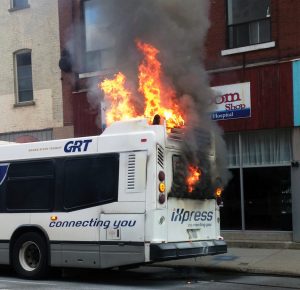Don't panic
GRT ridership numbers are down, but that’s no reason to reduce service or squeeze customers. Quite the opposite.
 Last month, Grand River Transit revealed ridership had dropped from a peak of 22 million rides in 2013 to just 20 million last year. Councillor Sean Strickland suggested that these changing trends could cause the Region to scale back its future plans for bus transit. (GRT is currently developing a new business plan. Overdue by at least a year, a draft is anticipated this fall.)
Last month, Grand River Transit revealed ridership had dropped from a peak of 22 million rides in 2013 to just 20 million last year. Councillor Sean Strickland suggested that these changing trends could cause the Region to scale back its future plans for bus transit. (GRT is currently developing a new business plan. Overdue by at least a year, a draft is anticipated this fall.)
While there are some nationwide and demographic trends at play, Waterloo Region shouldn’t be putting the brakes on its much needed transit expansion plans just yet. The bulk of the decline is attributed to school boards to use yellow buses instead of GRT for its high school routes. In essence, ridership growth hasn’t so much reversed as it has stalled.
But before we get into the details of why ridership growth may be slowing, it’s worth remembering that the starting year we choose for comparison can skew our conclusions, so we should be cautious about being too quick to declare a ‘trend.’ If we take a longer view, ridership has steadily climbed, more than doubling since 1999. And ridership on the central transit corridor has been ahead of projections for ION ridership. A temporary setback shouldn’t be seen as a long-term trend.
There are several reasons why fewer people may have taken transit in 2015:
- Transit fares have increased well beyond the rate of inflation over the last decade, making transit more difficult to afford (while core parking rates have been frozen or written off). Research literature suggests that fare increases can have long-term impacts.
- Construction detours have been particularly difficult for bus routes. Most routes serving Charles Street Terminal have been impacted, and the most heavily used routes, the 7 and the 200, have been diverted well out of their way. All this has made buses take longer, leading to missed connections and less reliability, which drives people to look for alternatives.
- Spring and summer transit service has been cut back. This has been particularly difficult on central routes like the 200, which has been cut from 10-minute headways to 15. Consequently, the likelihood of being left behind by an overcrowded bus has increased, with an even longer wait when that happens.
None of these factors need persist. Most ION construction should wrap up this year, and if Regional Council had the willpower, they could slow the pace of fare increases and restore lost service. Further cutting service or hiking fares to make up the difference could start a vicious cycle of low ridership and deeper cuts.
If anything, these temporary setbacks point to the need to continue to roll out a comprehensive frequent service network to attract ridership. Our Region continues to grow, and as core areas intensify, our roads will be overwhelmed if everyone feels they have no choice but to drive for daily needs. Reliable, affordable, easy-to-use transit will help ensure that we will have that choice.